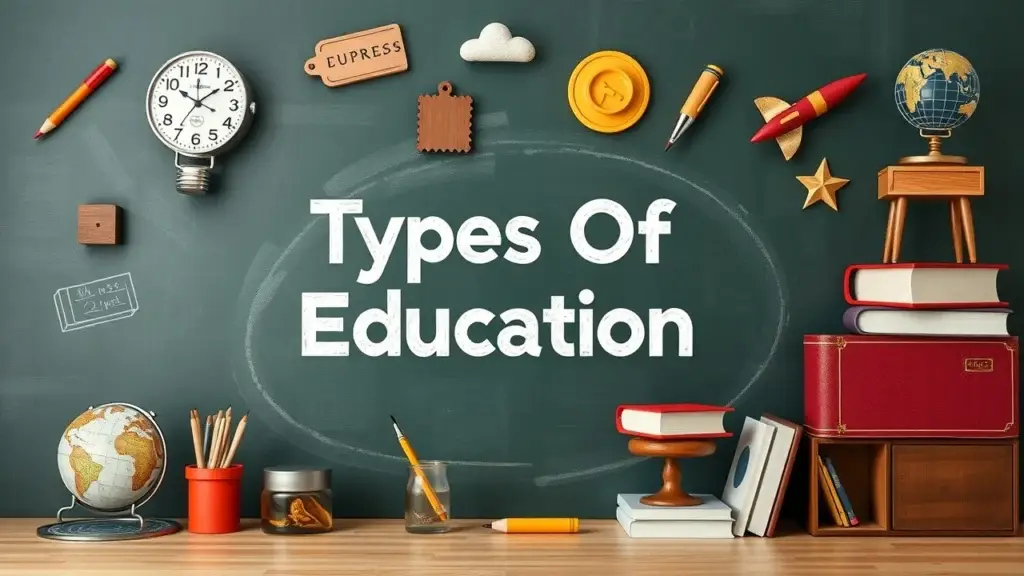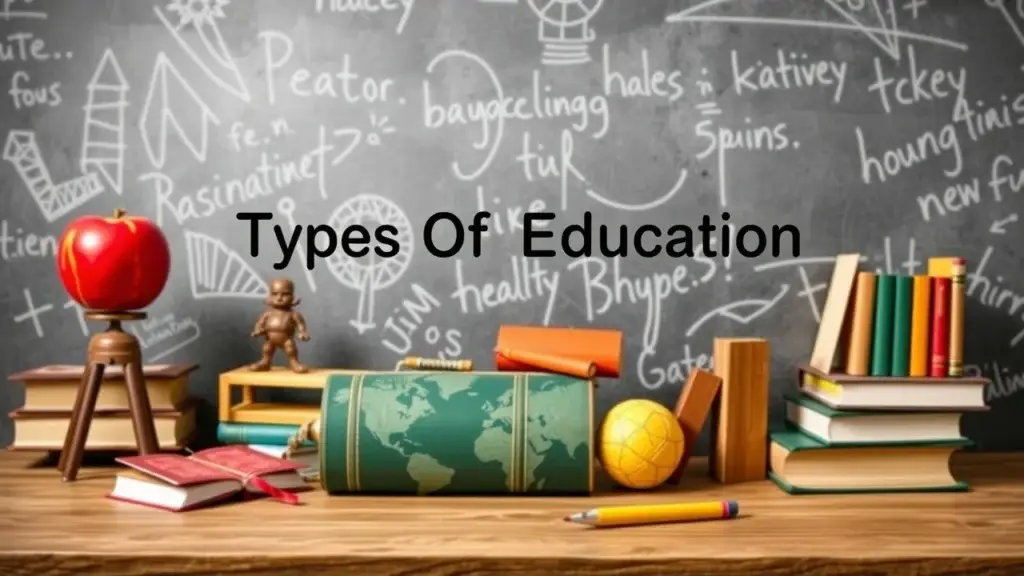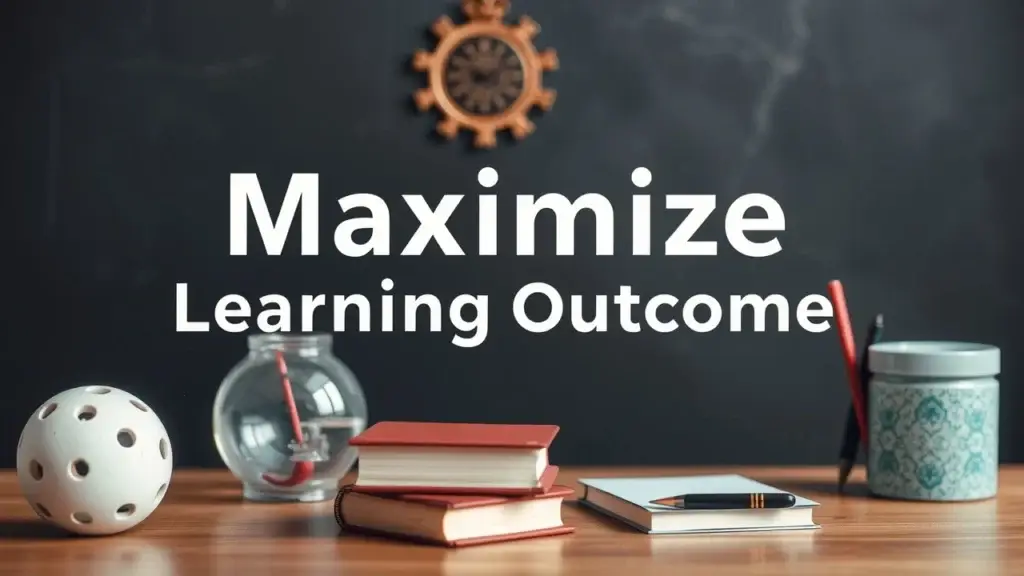Types of education are categorized into formal, informal, and non-formal learning. This guide explains the differences between these educational approaches, including examples.
What Are the Different Types of Education?

Education is super important for personal growth and helps society too. It also boosts economic development. There are different types of education that fit various learning needs and situations. Knowing about these can help people choose the right path for their education.
Definition of Education
Education is how we pass on knowledge, skills, values, and beliefs from one generation to another. This process helps improve educational attainment, encourages lifelong learning, and builds skill development in individuals. The benefits of education go beyond personal gains; it strengthens communities by creating informed individuals who positively impact society.
Overview of Educational Categories
Education can be divided into three main types: formal, informal, and non-formal education.
- Formal Education: This is structured and takes place in schools and universities. It follows a set curriculum designed for students at different levels—from K-12 education to higher education options like college degrees or vocational training programs.
- Informal Education: This type happens outside traditional classrooms. It includes self-directed learning experiences such as reading books, talking with peers or mentors, or joining community activities that enhance knowledge without following a specific program.
- Non-Formal Education: This combines elements of both formal and informal education. It offers organized learning outside traditional schooling but still has some structure—like adult education programs or skill-building workshops.
Each category has its own purpose and meets diverse learner needs at various life stages.
Why Understanding Educational Pathways Matters?
Knowing about different educational pathways helps individuals make better choices about their career paths and school options.
Impact on Career Opportunities
The educational path you choose can affect your future job chances and career readiness. For example:
- People who go through vocational training often find good jobs quickly because they gain practical skills during their studies.
- Higher academic qualifications may lead to advanced job positions needing specialized knowledge, but they also create more competition among graduates looking for similar roles.
Understanding how these factors work helps learners connect their education to the careers they want.
Adapting to Global Demands
In today’s world, where technology changes fast and job markets shift quickly, it’s key to adapt your educational approach. Being aware of global education trends lets individuals—and schools—update their strategies to meet new demands:
- Focusing on continuous professional growth means that both new workers (like recent grads) and experienced professionals stay competitive as industries change.
By knowing the differences between types of education—formal, informal, non-formal—people can better plan their paths toward success while contributing meaningfully to society.
What Is Formal Education?
Formal education is a way of learning that follows a set plan. It usually takes place in schools or universities where students learn from teachers. This kind of education uses a specific curriculum and standardized tests to guide how students learn.
Characteristics of Structured Learning Environments
Structured learning environments have clear goals. They include important elements like:
- Defined Curriculum: A clear plan that shows what students should learn at each grade level.
- Standardized Assessments: Tests that are given the same way to all students to check their progress and achievements.
- Qualified Educators: Teachers who have the right skills and training to teach effectively.
These features help make sure all students get a good education while keeping it consistent across different schools.
Levels Within Formal Education
Formal education has several key levels:
- Primary School – This stage helps young kids, usually ages 5 to 11, learn basic skills like reading, writing, and math.
- Secondary School – Students aged 12 to 18 build on what they learned before and dive deeper into different subjects.
- Higher Education – After high school, students can go to universities for undergraduate degrees (bachelor’s), graduate studies (master’s), or even doctoral programs (PhD). These institutions offer specialized knowledge in many fields.
Each level is important for helping individuals gain skills for their future.
Examples of Formal Educational Institutions Around the World
There are many types of formal educational institutions around the globe:
- Public Schools: These schools get money from the government and follow state guidelines to provide free education.
- Private Schools: They operate independently from government funding. These schools might offer special programs or religious teachings.
- Charter Schools: Funded by public money but run independently, these schools often try new teaching methods and have more flexible curricula than public schools.
- Vocational Training Programs: These focus on teaching practical skills for specific jobs through hands-on experience rather than just theory.
These various types show how formal education adapts in different places based on local needs and values.
Advantages of Formal Education
Formal education offers many benefits:
- Skill development that prepares students for jobs after they graduate.
- Access to resources like libraries with tons of information.
- Opportunities to meet peers and professionals, which helps build networks.
- Recognized qualifications that improve job chances.
Understanding the structure of formal education systems worldwide helps individuals make better choices about their own educational paths, whether for themselves or their children.
How Does Informal Education Work?
Informal education means learning that happens naturally, without a set plan. It occurs through everyday experiences and interactions. This is different from formal education, which follows strict guidelines within schools. Informal education offers flexibility and can adapt to what people are interested in and need. Often, it takes place in social settings where individuals learn from one another.
Examples of Informal Learning
Informal learning appears in many ways that each support personal growth:
- Hobbies: Activities like arts and crafts or sports help develop skills such as creativity and teamwork. These hobbies can be fun while also boosting cognitive abilities.
- Travel: Going to new places exposes individuals to different cultures. This enhances global awareness and personal development. Learning about other ways of life can build adaptability.
- Work Experience: Internships or volunteer work provide hands-on knowledge. They help people apply what they have learned in school to real situations while developing important soft skills.
Benefits and Drawbacks of Informal Learning
Advantages
- Flexibility: Learners can set their own schedules, allowing for personalized exploration.
- Self-directed Exploration: People are encouraged to chase their interests independently, which promotes ownership of their learning.
- Cost-effective: Informal learning often doesn’t require tuition fees or structured programs, making it less expensive than formal education.
Disadvantages
- Lack of Structure: Some learners may miss important knowledge due to the absence of a defined plan.
- Measurement Challenges: Outcomes from informal learning are harder to measure compared to formal assessments, making it difficult to recognize achievements.
- Resource Limitations: Finding expert guidance or specific materials may be tougher outside structured environments.
Role in Lifelong Learning
Incorporating informal learning into life is key for ongoing personal development throughout adulthood. It supports skill-building beyond traditional schooling by encouraging curiosity-driven activities like reading books outside of a classroom setting or participating in community programs that broaden perspectives.
Informal education plays an essential role alongside formal systems by providing various ways for lifelong learning that fit individual goals and changes in society. Embracing both structured education and informal methods allows people to build diverse skills necessary for facing challenges in today’s world while pursuing their unique paths in life.
Understanding Non-Formal Education

Non-formal education is a type of learning that happens outside the traditional school system. It includes things like community colleges, workshops, online courses, and apprenticeships. This kind of education stands out because it’s flexible. Students can learn at their own pace and focus on what they need most.
When we compare non-formal education to formal and informal education, we see key differences. Formal education follows a set curriculum with recognized qualifications. Informal education happens through everyday experiences and self-directed learning. Non-formal education combines aspects of both, focusing on practical skills useful in real life. This makes it especially attractive for adults wanting to improve their careers or personal skills.
Examples of Non-Formal Educational Opportunities
You can find many non-formal educational options that cater to different interests:
- Community Colleges: These schools offer skill-specific programs that help students gain immediate employment or further their studies. They often have classes that fit into the busy schedules of working adults.
- Workshops: These are short-term classes designed for professional growth in various fields like technology, arts, or business management. Workshops are typically hands-on and interactive, making them engaging.
- Online Courses: With so many digital platforms available today, online courses cover everything from coding to creative writing. They give people access to quality instruction no matter where they live.
Advantages and Disadvantages of Non-Formal Education
Advantages
- Accessibility for Diverse Learners: Non-formal education opens doors for those who might struggle in traditional settings due to jobs or other responsibilities.
- Focus on Practical Skills Relevant to the Job Market: Many programs get input from industry professionals, ensuring that participants learn skills they can actually use at work.
- Flexible Scheduling Options Allowing Balance with Work/Life Commitments: A lot of non-formal programs offer classes during evenings or weekends so that students can juggle their personal lives with their educational goals.
Disadvantages
- Lack of Standardized Accreditation Compared to Formal Institutions: Even though many non-formal programs provide excellent training, they might not be recognized by employers as much as degrees from accredited universities.
- Potential Variability in Quality Across Different Programs or Providers: Not every program is created equal; some may be less rigorous than others. It’s important for learners to research a program’s reputation before signing up.
Role in Skill Development and Lifelong Learning
Non-formal education plays a big role in helping people develop new skills throughout their lives:
- People can enjoy continuous personal growth by engaging in different learning experiences outside traditional school settings; this keeps them curious and open to new ideas.
- As job markets shift rapidly due to technology, keeping skills up-to-date is essential for career success; lifelong learning becomes necessary for staying relevant.
In summary, non-formal education has great value in today’s educational landscape. It effectively serves diverse learner groups through accessible formats focused on individual goals and aspirations.
Distance Learning/Online Education: Accessibility and Flexibility
Distance learning, also known as online education or e-learning, has changed how we think about learning. It offers accessible and flexible choices for students. This way of studying lets people learn from anywhere, making it easier for those who juggle work, family, or other commitments. Virtual schools and blended learning mix traditional classes with online options, which adds to this flexibility.
Definition and Types of Online/Distance Learning
Online education includes different formats that cater to various needs. Here are the main types:
- Synchronous Learning: Students attend live classes at scheduled times using video tools. This setup allows real-time discussions between teachers and students.
- Asynchronous Learning: In this model, students can access course materials at any time. This is great for those with busy or unpredictable schedules.
- Blended Learning: This combines both synchronous and asynchronous methods. Students may go to some classes in person while completing others online.
These different formats make it possible for many kinds of learners to find what suits them best.
Advantages and Disadvantages of Online Learning
Online education offers many benefits:
- Accessibility: People in remote areas can reach quality educational resources without being limited by location.
- Flexibility: Students can plan their studies around their personal lives.
- Variety of Courses: There are countless subjects available across many platforms.
But there are some downsides too:
- Less Social Interaction: Without face-to-face time, making connections with classmates can be tough.
- Need for Self-Motivation: Success in online settings often relies on individual discipline; not everyone thrives in this type of environment.
- Tech Dependence: Good internet access and knowledge of digital tools are essential for participation.
By weighing these pros and cons, potential students can choose their educational paths wisely.
Choosing Reputable Online Learning Platforms and Programs
When picking a platform for distance learning, it’s important to find one that offers quality education:
- Look for accredited schools that provide recognized degrees or certifications.
- Check reviews from current or former students about the program’s effectiveness.
- Talk to educational technology specialists who can help you find user-friendly platforms that offer solid support.
Picking trustworthy providers increases your chances of a positive experience in online education.
Effectiveness of Online Learning: Research and Evidence
Research shows mixed results when comparing online learning to traditional classrooms. Studies indicate that well-designed courses with interactive elements like discussion forums often yield similar outcomes as in-person classes (U.S Department of Education). Additionally, having an active instructor presence can significantly boost student satisfaction rates in online courses (Educational Research Review).
Understanding these details about distance learning can help parents, adult learners, educators, and professionals make better choices in today’s varied educational landscape.
Selecting the Right Educational Path
Choosing an educational path is a big deal. It can really shape what opportunities you have in the future and how your career turns out. There are many types of education, and knowing your options is super important for parents, students, and teachers. This section will talk about how to look at personal needs and goals when picking the right pathway.
Assessing Individual Needs and Goals
When looking at different educational pathways, it’s important to think about personal learning styles, budget limits, time available, career dreams, and overall educational goals. Every student is unique; some do better in structured environments like traditional schools while others shine in flexible setups such as online or alternative education programs.
Learning Styles: It helps to know if a student learns best with visual aids, hands-on tasks, or listening. This can help decide between regular classrooms and personalized learning methods.
Budget: Money matters a lot when choosing education. Public schools often cost less than private ones or specialized training programs that may need more money.
Time Constraints: The time available for study also plays a big role. If someone works full-time, they might need part-time studies or online courses that allow for more flexibility.
Career Aspirations: Knowing long-term career goals helps pick the right path—whether it’s vocational training for quick employment or college degrees for advanced roles in specific fields.
Factors to Consider When Choosing an Educational Path
There are several key factors to consider when thinking about potential educational routes:
- School Funding: How local governments fund schools impacts the quality of public systems compared to private options.
- Curriculum Development: Schools have different curricula based on state standards; understanding these helps align with student interests.
- Educational Standards: Accreditation makes sure schools meet certain benchmarks. This affects both the quality of education and how employers view it.
- Personalized Learning Opportunities: Some systems offer experiences that cater specifically to individual strengths—this can be very helpful for many learners who benefit from custom approaches rather than one-size-fits-all methods.
Decision-Making Process: A Checklist for Individuals and Parents
To help make informed choices about educational paths:
- Identify your child’s learning style.
- Check your budget regarding tuition fees.
- Think about the time commitments each option needs (full-time vs part-time).
- Research potential career outcomes linked to different types of education.
- Look into support services offered by schools (like counseling).
Parental involvement is crucial here; being engaged not only supports kids emotionally but also provides guidance based on experiences from navigating similar situations themselves.
Real-World Examples and Case Studies: Diverse Educational Journeys
Looking at real-life examples shows how different paths can lead people to success:
- Alternative Education Options (Homeschooling): Families who choose homeschooling often mention how helpful personalized attention is in meeting their children’s needs while allowing flexibility in lesson scheduling.
- Community Colleges vs Universities: Community colleges provide an easy entry into higher education without the high costs that come with four-year universities—offering valuable vocational training along with academic courses aimed at degree completion later if that’s desired.
By carefully looking at personal situations against available options within various types of education frameworks—like traditional schooling models alongside innovative alternatives—students can make well-informed choices leading them towards satisfying careers that match their goals.
Maximizing Learning Outcomes

Time Management and Organization Strategies
Good time management helps students achieve academic success. It allows them to prioritize tasks, lower stress, and boost productivity. Strong organizational skills are key to creating effective study habits. Here are some strategies to improve time management:
- Create a Schedule: Outline daily activities. Include class times, study sessions, and breaks.
- Set Priorities: Identify the most pressing assignments and focus on those first.
- Break Tasks Down: Divide larger projects into smaller, manageable steps.
- Use Tools: Consider planners or digital calendars to track deadlines.
- Establish Goals: Set short-term (daily) and long-term (semester) goals to maintain focus.
Active Learning Techniques
Active learning boosts student engagement and critical thinking skills. Here are effective methods to promote active learning:
- Group Discussions: Encourage collaboration and sharing diverse viewpoints. This deepens understanding through interaction.
- Hands-On Projects: Allow students to apply theoretical knowledge practically, such as conducting science experiments.
- Technology Integration: Use online forums for discussions or collaborative tools like Google Docs for feedback.
Building a Supportive Learning Community
Creating a supportive learning community is vital for educational success. Here’s how it helps:
- Parent Involvement: Active participation from parents contributes positively to school culture.
- Peer Support: Opportunities for peer collaboration enhance motivation and collective success.
Utilizing Technology Effectively in Learning
Integrating technology into education has changed teaching methods significantly. Some useful tools include:
- Study Apps: Flashcard applications can aid memorization.
- Collaborative Workspaces: Tools that allow seamless communication among team members working remotely.
Addressing Challenges in Different Learning Environments
Students face various challenges across learning environments, whether formal or informal. Here are common issues and solutions:
- Inclusive Classrooms: Ensure all students feel valued and supported.
- Special Needs Instruction: Adapt teaching methods to meet diverse needs through differentiated instruction strategies.
By implementing these strategies, students can maximize their learning outcomes while engaging with their studies meaningfully. Each component plays a role in building a robust educational experience that supports success inside and outside the classroom.
Future of Education
Emerging Trends in Education
The education field is changing fast. One major trend is personalized learning. This means teachers are focusing on what each student needs, rather than using a one-size-fits-all approach. By doing this, students can engage more and learn better.
Another big change comes from artificial intelligence (AI). Schools are using AI tools to help track how students are doing. These tools can spot areas where a student might need help. Also, AI tutoring systems can provide extra support outside the classroom.
Micro-credentials are becoming popular too. They are short courses that focus on specific skills instead of a full degree. This allows people to learn quickly and gain skills that employers want right away.
The Impact of Technology on the Future of Education
Technology is reshaping classrooms in exciting ways. Tools like interactive whiteboards and virtual reality (VR) create fun and engaging learning experiences. Students can explore new ideas through these technologies, making tough subjects easier to understand.
Online education has also taken off. Many people can now access distance learning options that fit their lives better. There are live classes where students can interact in real-time, as well as recorded classes they can watch anytime. This flexibility is great for adults who may have jobs or family commitments.
Moreover, video conferencing software allows students to work together remotely. They can join group discussions from anywhere, keeping engagement high through features like breakout rooms.
Frequently Asked Questions About Types of Education
What are the main types of education?
The three main types of education are formal, informal, and non-formal. Each type offers unique benefits and learning experiences.
How do different educational systems compare?
Formal education follows a structured curriculum in schools. Non-formal education is flexible, catering to specific needs outside traditional schooling. Informal education happens naturally through everyday experiences.
What are some alternative education options?
Alternative options include homeschooling, Montessori education, Waldorf education, and online learning platforms. Each provides tailored approaches for diverse learner needs.
What is vocational training?
Vocational training prepares students for specific careers through hands-on experience. It focuses on practical skills that align with job market demands.
What is lifelong learning?
Lifelong learning emphasizes ongoing skill development throughout life. It includes continuing education programs, workshops, and adult learning opportunities.
How do I choose the right educational path for myself or my child?
Assess personal interests and goals. Consider individual learning styles, time commitments, and budget constraints. Research various educational options to find the best fit.
What career paths are associated with higher education options?
Higher education can lead to careers in fields like healthcare, engineering, business, and education. Advanced degrees often open doors to specialized positions requiring expertise.
Additional Insights on Types of Education
- Educational Philosophy: Different philosophies shape teaching methods and curricula.
- Inclusive Education: Focuses on meeting diverse needs in the classroom.
- School Choice: Parents can select from public, private, charter, or magnet schools.
- Career and Technical Education (CTE): Prepares students for immediate employment with practical skills.
- Educational Technology: Integrates digital tools into learning environments for enhanced engagement.
- Micro-Credentials: Short courses provide specific skill training without requiring full degrees.
- Apprenticeship Programs: Combine work experience with classroom instruction for hands-on learning.
- Accreditation: Ensures quality standards in educational institutions and programs.
- Special Needs Education: Tailors teaching approaches to support students with disabilities effectively.
- Student Support Services: Schools offer counseling and resources to help all learners succeed.
These insights highlight the diverse landscape of education available today. Each type plays a crucial role in developing knowledge and skills for various life paths.
Related Topics
- types of learning styles
- types of schools
- types of educational institutions
- types of online learning
- types of vocational training
- types of higher education
- types of educational philosophies
- types of learning environments
- types of educational technologies
- types of educational resources
- types of career paths
- types of student support services
- types of alternative education
- types of assessments
- types of micro-credentials
- types of learning communities



Types of Education: Formal, Informal, and Non-Formal Learning Explained